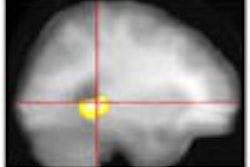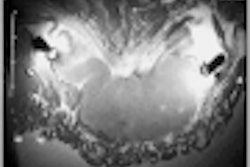Pillows that contain virtually undetectable metal springs could be a serious hazard in the MR environment, according to a report from Scotland's Institute of Neurological Sciences in Glasgow.
The incident involved a patient who was transferred from a hospital bed to a nonferromagnetic MR patient trolley. Because the patient was in pain, three pillows were put on the trolley. As she was being transferred to the examination table in the MR suite, one of the pillows "rotated and rapidly accelerated into the magnet. After passing through the isocentre it decelerated until it reversed its direction of motion. It then oscillated back and forth along the bore of the magnet until frictional forces brought it to rest close to the isocentre," the authors wrote (The British Journal of Radiology, September 2001, Vol.74:884, pp. 847-851).
Fortunately, the patient was not injured and the pillow was forcibly removed from the magnet so the exam could continue. However, a test with a hand-held horseshoe magnet, producing a field of 237 mT at the pole pieces, did not pick up any force of attraction.
Once the pillow (Air Stream, John Cotton, Mirfield, West Yorkshire, U.K.) was cut open, the group found a pack of 40 very fine springs sandwiched in between the padding material, which had a minimum thickness of 10 cm.
"The total mass of metal in the pillow was 146 g, amounting to 16% of the mass of the pillow," they wrote.
The authors then measured the force at which such an object would be drawn into an MR unit and whether it could potentially cause injury to a patient. Tests were done on a 1.5-tesla 63SP Magnetom (Siemens Medical Solutions, Iselin, NJ). According to the results, the pillow reached a maximum velocity of 33.7 km/h-1 after undergoing a maximum acceleration of 9.9 g force.
"In general, if a head is subject to a sufficiently large force that is forwards and upwards [and] a patient with the head resting on the ferromagnetic pillow is introduced feet first into the magnet, a disruptive hyperflexion injury may potentially result," they hypothesized.
But because the flexion point for the pillow was at 49% of the lowest level required to produce injury, it was unlikely to have caused significant damage to a normal spine, they stated. In addition, the low level of torque produced by the pillow being drawn into the magnet (38% of the level required for injury) would not cause serious damage.
The authors cautioned that both of those measurements are based on the impact to a healthy spine. Patients with existing instability or injury may be at a greater risk. The moving pillow also could gain enough momentum to pull out any injection or infusion lines.
"That a powerful hand-held magnet did not reveal the presence of ferromagnetic material in the pillow raises wider concerns," they concluded. "Hand-held magnets should not be considered a foolproof means of identifying missile potential."
By Shalmali PalAuntMinnie.com staff writer
September 26, 2001
Related Reading
Of missiles and metallic objects: How to avoid MRI-related hazards, August 21, 2001
Healthcare safety institute issues MRI precautions, August 14, 2001
Copyright © 2001 AuntMinnie.com



.fFmgij6Hin.png?auto=compress%2Cformat&fit=crop&h=100&q=70&w=100)




.fFmgij6Hin.png?auto=compress%2Cformat&fit=crop&h=167&q=70&w=250)











